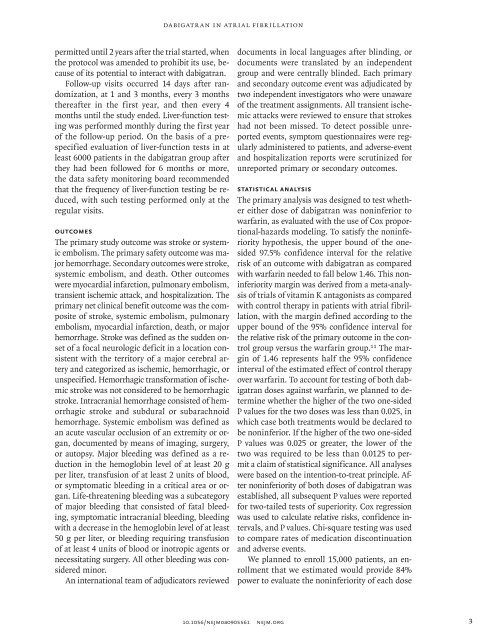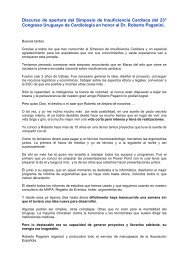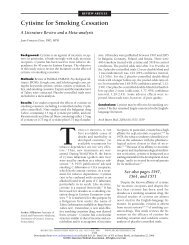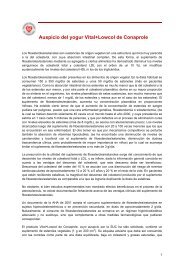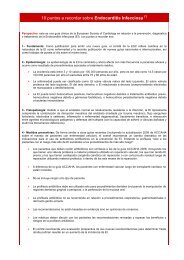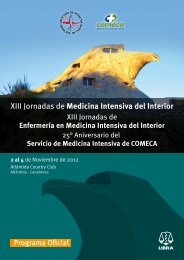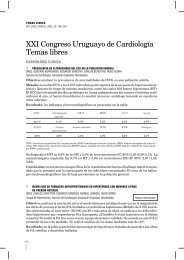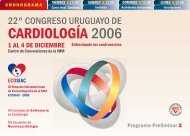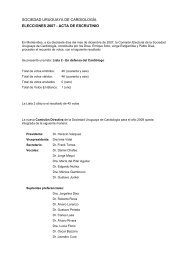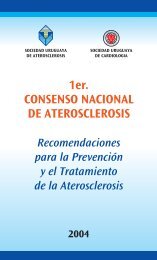The new england journal of medicine
The new england journal of medicine
The new england journal of medicine
You also want an ePaper? Increase the reach of your titles
YUMPU automatically turns print PDFs into web optimized ePapers that Google loves.
Dabigatran in Atrial Fibrillation<br />
permitted until 2 years after the trial started, when<br />
the protocol was amended to prohibit its use, because<br />
<strong>of</strong> its potential to interact with dabigatran.<br />
Follow-up visits occurred 14 days after randomization,<br />
at 1 and 3 months, every 3 months<br />
thereafter in the first year, and then every 4<br />
months until the study ended. Liver-function testing<br />
was performed monthly during the first year<br />
<strong>of</strong> the follow-up period. On the basis <strong>of</strong> a prespecified<br />
evaluation <strong>of</strong> liver-function tests in at<br />
least 6000 patients in the dabigatran group after<br />
they had been followed for 6 months or more,<br />
the data safety monitoring board recommended<br />
that the frequency <strong>of</strong> liver-function testing be reduced,<br />
with such testing performed only at the<br />
regular visits.<br />
Outcomes<br />
<strong>The</strong> primary study outcome was stroke or systemic<br />
embolism. <strong>The</strong> primary safety outcome was major<br />
hemorrhage. Secondary outcomes were stroke,<br />
systemic embolism, and death. Other outcomes<br />
were myocardial infarction, pulmonary embolism,<br />
transient ischemic attack, and hospitalization. <strong>The</strong><br />
primary net clinical benefit outcome was the composite<br />
<strong>of</strong> stroke, systemic embolism, pulmonary<br />
embolism, myocardial infarction, death, or major<br />
hemorrhage. Stroke was defined as the sudden onset<br />
<strong>of</strong> a focal neurologic deficit in a location consistent<br />
with the territory <strong>of</strong> a major cerebral artery<br />
and categorized as ischemic, hemorrhagic, or<br />
unspecified. Hemorrhagic transformation <strong>of</strong> ischemic<br />
stroke was not considered to be hemorrhagic<br />
stroke. Intracranial hemorrhage consisted <strong>of</strong> hemorrhagic<br />
stroke and subdural or subarachnoid<br />
hemorrhage. Systemic embolism was defined as<br />
an acute vascular occlusion <strong>of</strong> an extremity or organ,<br />
documented by means <strong>of</strong> imaging, surgery,<br />
or autopsy. Major bleeding was defined as a reduction<br />
in the hemoglobin level <strong>of</strong> at least 20 g<br />
per liter, transfusion <strong>of</strong> at least 2 units <strong>of</strong> blood,<br />
or symptomatic bleeding in a critical area or organ.<br />
Life-threatening bleeding was a subcategory<br />
<strong>of</strong> major bleeding that consisted <strong>of</strong> fatal bleeding,<br />
symptomatic intracranial bleeding, bleeding<br />
with a decrease in the hemoglobin level <strong>of</strong> at least<br />
50 g per liter, or bleeding requiring transfusion<br />
<strong>of</strong> at least 4 units <strong>of</strong> blood or inotropic agents or<br />
necessitating surgery. All other bleeding was considered<br />
minor.<br />
An international team <strong>of</strong> adjudicators reviewed<br />
documents in local languages after blinding, or<br />
documents were translated by an independent<br />
group and were centrally blinded. Each primary<br />
and secondary outcome event was adjudicated by<br />
two independent investigators who were unaware<br />
<strong>of</strong> the treatment assignments. All transient ischemic<br />
attacks were reviewed to ensure that strokes<br />
had not been missed. To detect possible unreported<br />
events, symptom questionnaires were regularly<br />
administered to patients, and adverse-event<br />
and hospitalization reports were scrutinized for<br />
unreported primary or secondary outcomes.<br />
Statistical Analysis<br />
<strong>The</strong> primary analysis was designed to test whether<br />
either dose <strong>of</strong> dabigatran was noninferior to<br />
warfarin, as evaluated with the use <strong>of</strong> Cox proportional-hazards<br />
modeling. To satisfy the noninferiority<br />
hypothesis, the upper bound <strong>of</strong> the onesided<br />
97.5% confidence interval for the relative<br />
risk <strong>of</strong> an outcome with dabigatran as compared<br />
with warfarin needed to fall below 1.46. This noninferiority<br />
margin was derived from a meta-analysis<br />
<strong>of</strong> trials <strong>of</strong> vitamin K antagonists as compared<br />
with control therapy in patients with atrial fibrillation,<br />
with the margin defined according to the<br />
upper bound <strong>of</strong> the 95% confidence interval for<br />
the relative risk <strong>of</strong> the primary outcome in the control<br />
group versus the warfarin group. 11 <strong>The</strong> margin<br />
<strong>of</strong> 1.46 represents half the 95% confidence<br />
interval <strong>of</strong> the estimated effect <strong>of</strong> control therapy<br />
over warfarin. To account for testing <strong>of</strong> both dabigatran<br />
doses against warfarin, we planned to determine<br />
whether the higher <strong>of</strong> the two one-sided<br />
P values for the two doses was less than 0.025, in<br />
which case both treatments would be declared to<br />
be noninferior. If the higher <strong>of</strong> the two one-sided<br />
P values was 0.025 or greater, the lower <strong>of</strong> the<br />
two was required to be less than 0.0125 to permit<br />
a claim <strong>of</strong> statistical significance. All analyses<br />
were based on the intention-to-treat principle. After<br />
noninferiority <strong>of</strong> both doses <strong>of</strong> dabigatran was<br />
established, all subsequent P values were reported<br />
for two-tailed tests <strong>of</strong> superiority. Cox regression<br />
was used to calculate relative risks, confidence intervals,<br />
and P values. Chi-square testing was used<br />
to compare rates <strong>of</strong> medication discontinuation<br />
and adverse events.<br />
We planned to enroll 15,000 patients, an enrollment<br />
that we estimated would provide 84%<br />
power to evaluate the noninferiority <strong>of</strong> each dose<br />
10.1056/nejmoa0905561 nejm.org 3


